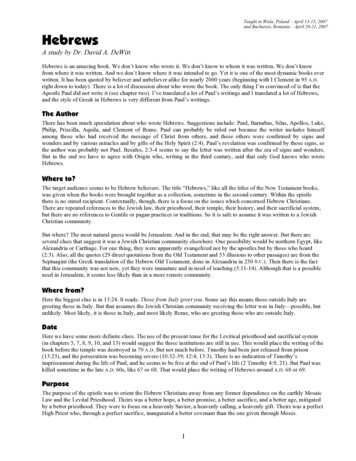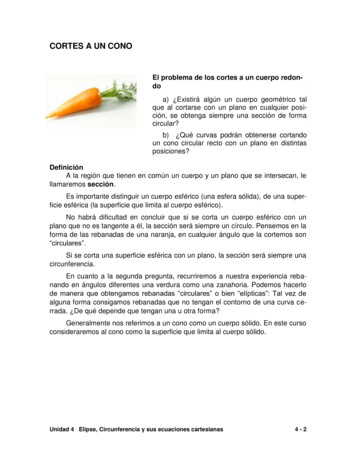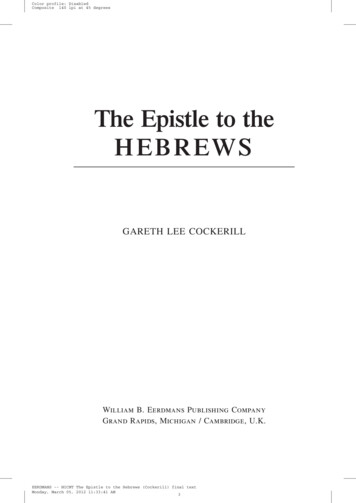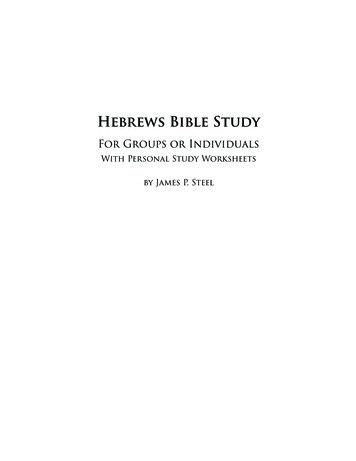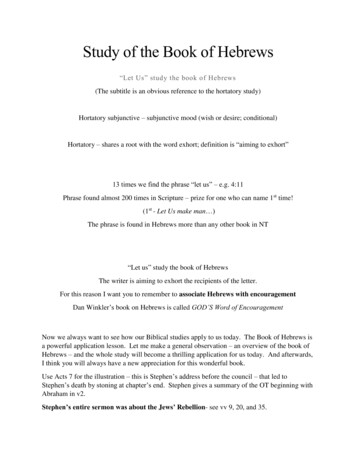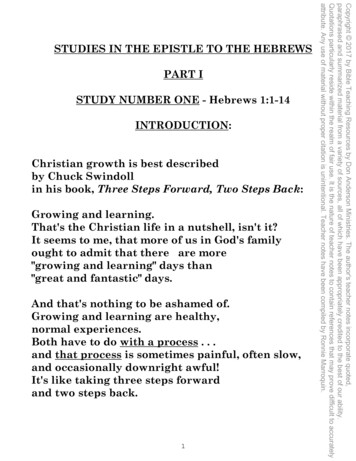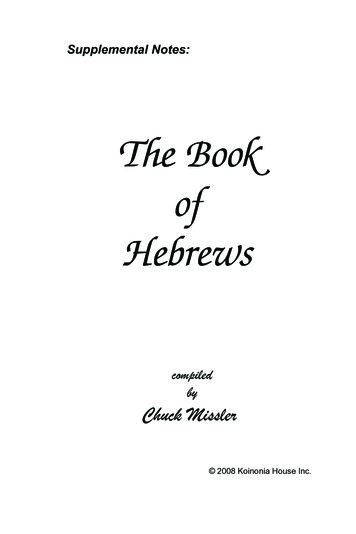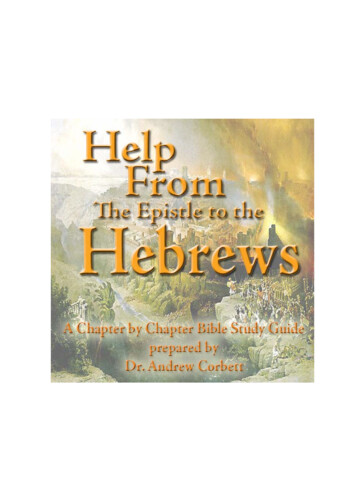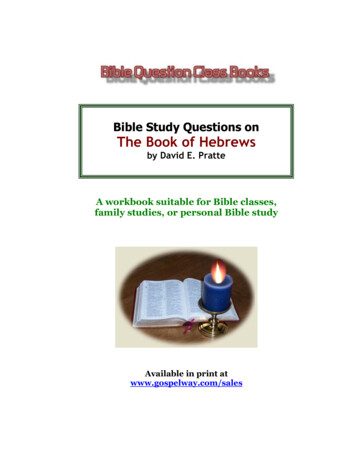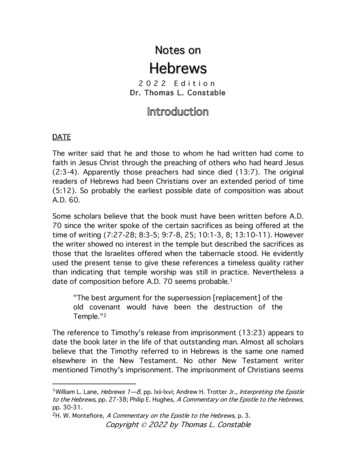
Transcription
Notes onHebrews2 0 2 2 E d i t i o nDr. Thomas L. ConstableDATEThe writer said that he and those to whom he had written had come tofaith in Jesus Christ through the preaching of others who had heard Jesus(2:3-4). Apparently those preachers had since died (13:7). The originalreaders of Hebrews had been Christians over an extended period of time(5:12). So probably the earliest possible date of composition was aboutA.D. 60.Some scholars believe that the book must have been written before A.D.70 since the writer spoke of the certain sacrifices as being offered at thetime of writing (7:27-28; 8:3-5; 9:7-8, 25; 10:1-3, 8; 13:10-11). Howeverthe writer showed no interest in the temple but described the sacrifices asthose that the Israelites offered when the tabernacle stood. He evidentlyused the present tense to give these references a timeless quality ratherthan indicating that temple worship was still in practice. Nevertheless adate of composition before A.D. 70 seems probable.1"The best argument for the supersession [replacement] of theold covenant would have been the destruction of theTemple."2The reference to Timothy's release from imprisonment (13:23) appears todate the book later in the life of that outstanding man. Almost all scholarsbelieve that the Timothy referred to in Hebrews is the same one namedelsewhere in the New Testament. No other New Testament writermentioned Timothy's imprisonment. The imprisonment of Christians seems1WilliamL. Lane, Hebrews 1—8, pp. lxii-lxvi; Andrew H. Trotter Jr., Interpreting the Epistleto the Hebrews, pp. 27-38; Philip E. Hughes, A Commentary on the Epistle to the Hebrews,pp. 30-31.2H. W. Montefiore, A Commentary on the Epistle to the Hebrews, p. 3.Copyright Ó 2022 by Thomas L. Constable
Dr. Constable's Notes on Hebrews22022 Editionto have been a well-known fact of life (10:34; 13:3). This was true afterNero launched an empire-wide persecution in A.D. 64. All of these factors,when taken together, seem to point to a writing date near A.D. 68-69.1WRITERAs to authorship, most students of this subject are not dogmatic or evencertain, for good reason.2 As early as Origen, the Alexandrian church fatherwho died about A.D. 255, no one knew who the writer was for sure. Aftercareful study of the authorship of Hebrews, Origen wrote: "But who it wasthat really wrote the epistle, God only knows."3"The language of the Epistle is both in vocabulary and stylepurer and more vigorous than that of any other book of theNew Testament. The vocabulary is singularly copious. Itincludes a large number of words which are not foundelsewhere in the apostolic writings, very many of which occurin this book only among the Greek Scriptures "4"All that can be said with certainty is that Hebrews wascomposed by a creative theologian who was well trained in theexposition of the Greek Scriptures. He was surely ahellenistic Jewish-Christian."51SeeRichard C. H. Lenski, The Interpretation of The Epistle to the Hebrews and The Epistleof James, p. 22; Robert G. Gromacki, Stand Bold in Grace, p. 16; J. Paul Tanner, "TheEpistle to the Hebrews," in The Grace New Testament Commentary, 2:1032.2See Hughes, pp. 19-30; Trotter, pp. 39-57; or Donald A. Carson and Douglas J. Moo, AnIntroduction to the New Testament, pp. 600-4; for good discussions of authorship.3Eusebius, The Ecclesiastical History of Eusebius Pamphilus, p. 247.4Brooke Foss Westcott, The Epistle to the Hebrews, p. xliv. Paragraph division omitted.See Trotter, pp. 117-43.5Lane, p. xlix.
2022 EditionDr. Constable's Notes on Hebrews3Commentators have made cases for the writer being Paul,1 Apollos,2Barnabas,3 Luke,4 Peter, Jude, Stephen, Silvanus (Silas), Epaphras(Epaphroditus), Philip the Evangelist, Priscilla,5 Mary the mother of Jesus,Clement of Rome, Aristion, and others. However, the masculine participlediegoumenon ("to tell"), which refers to the writer in 11:32, would seemto rule out a female writer. Ancient testimony mentioned only fourpossibilities: Paul, Luke, Barnabas, and Clement.6 None of thesesuggestions has found enthusiastic general reception for various reasons.Probably we should be content to share Origen's agnosticism on thisquestion and look forward to getting the answer in heaven.7"The absence both of solid testimony, internal or external, andof any firm traditions means that, as things are, the riddle ofthe authorship of Hebrews is incapable of solution."8The early Christians originally accepted all the New Testament books asinspired by God because they each contained teaching from an officialapostle. For this reason the writer was probably either an apostle or a closeassociate of at least one of the apostles (cf. 13:23).1MatthewHenry, Commentary on the Whole Bible, p. 1929; W. J. Conybeare, in The Lifeand Epistles of St. Paul, pp. 788-790; Robert Jamieson, A. R. Fausset, and David Brown,Commentary Practical and Explanatory on the Whole Bible, pp. 1393-95; J. N. Darby,Synopsis of the Books of the Bible, 5:269; G. Campbell Morgan, An Exposition of the WholeBible, p. 518; Adolph Saphir, The Epistle to the Hebrews, 1:19, footnote 10; Arno C.Gaebelein, The Annotated Bible, 4:1:230-32; William R. Newell, Hebrews Verse by Verse,p. 493; Arthur W. Pink, An Exposition of Hebrews, pp. 18-21; J. Sidlow Baxter, Explore theBook, 6:275; Ray C. Stedman, What More Can God Say? p. 3; J. Vernon McGee, Thru theBible with J. Vernon McGee, 5:503.2Lenski, pp. 21-22; A. T. Robertson, Word Pictures in the New Testament, 5:329.3Tertullian,cited by Jamieson, et al., p. 1393.Campbell Morgan, The Unfolding Message of the Bible, p. 359; David L. Allen, LukanAuthorship of Hebrews.5Adolph Harnack, "Probabilia über die Adresse und den Verfasser des Hebräerbriefs,"Zeitschrift für die Neutestamentliche Wissenschaft, I (1900):16-41.6See Gregory Goswell, "Finding a Home for the Letter to the Hebrews," Journal of theEvangelical Theological Society 59:4 (2016):747-60 for discussion of the placement ofHebrews in various ancient editions of the New Testament.7See Paul Ellingworth, The Epistle to the Hebrews: A Commentary on the Greek Text, pp.3-21.8Hughes, p. 19.4G.
4Dr. Constable's Notes on Hebrews2022 EditionRECIPIENTSThe original recipients of the epistle are also unknown. The title "The Epistleto the Hebrews" implies that they were Jewish Christians. This title isancient and is probably a safe guide to the identity of the first readers.References in the epistle also suggest that the original readers were mainlyJewish. The writer assumed, as we can infer from his material, that hisreaders were very familiar with the institutions of Judaism. The warningsagainst turning away from Jesus Christ back to the Old Covenant also implythe Jewish identity of his original audience.Other indications of a Jewish target audience are the emphasis on thesuperior priesthood of Jesus and the many appeals to the authority of theHebrew Scriptures. However the brand of Judaism in view seems to havebeen Hellenistic rather than Palestinian (Hebraic). While conceding that itis now impossible to identify the original recipients exactly, some respectedscholars favor the theory that they were probably former Jewish priests,probably of the Essene variety.1The reference to the generosity of the readers and their helping otherbelievers (6:10) suggests that the original audience did not live in Palestine.The Palestinian churches had a reputation for needing material assistance,rather than for giving it to other Christians (cf. Rom. 15:25-31; 1 Cor.16:3). Probably, therefore, they were Jews of the Diaspora. This conclusionhas support in the writer's consistent use of the Septuagint Old Testamentversion. All the quotations from the Old Testament, except two (10:30;13:5), are taken from the Septuagint (LXX).2 Hellenistic Jews used thistranslation widely, but Palestinian Jews did not use it as much. Argumentsfor the recipients being Palestinian Jews include their intimate knowledgeof temple rituals and their opportunity to escape suffering by convenientlyreturning to the observance of Jewish practices and feasts.3 I think thearguments for their living outside Palestine are stronger.In most of the New Testament churches there was a mixture of Jewish andGentile believers. The appeal of this epistle would certainly have been asgreat to Gentiles, who were tempted to return to paganism, as it would1Seeibid., pp. 10-15.et al., p. 1393. The Septuagint (Greek) translation of the Old Testament wasmade in the third century B.C. and is often abbreviated LXX.3See Pink, p. 11; J. Dwight Pentecost, A Faith That Endures, pp. 12-13; and Hughes, pp.15-19.2Jamieson,
2022 EditionDr. Constable's Notes on Hebrews5have been to Jews who faced temptation to return to Judaism. Howeverthe writer's primary concern appears to have been that,his Jewish readerswere failing to appreciate that Christianity is the divinely revealedsuccessor to Judaism. He did not want them to abandon Christianity andreturn to Judaism.Probably the letter originally went to a house-church outside of Palestinethat had a strong Hellenistic Jewish population. This church may have beenin or near Galatia, in view of conditions that existed there that the Epistleto the Galatians reflects. However they may very well have lived in anotherarea. Many scholars believe that the letter went first to a church in or nearRome.1 Evidently knowledge of where the original recipients liveddisappeared about the same time as knowledge of who the writer was.2Robert Gromacki summarized the internal evidence of the audience'sidentity well: First, they were believers. Second, they were immature. Third,they were wavering in their faith. Fourth, they were apparently well knownto the writer. Fifth, they resided either in Rome or in Palestine.3PLACE OF ORIGINIn view of 13:24b it has seemed to some scholars that the writer was inItaly when he sent this epistle, perhaps in Rome. However the expression"from Italy" in that verse probably refers to those living outside Italy, suchas Priscilla and Aquila, who were Jews forced to leave Rome by EmperorClaudius' edict in A.D. 49 (Acts 18:2).4 This expression suggests that thewriter was not in Italy when he wrote.1SeeLenski, pp. 14-21; Lane, pp. lviii-lx; Ellingworth, p. 29; Donald Guthrie, The Letter tothe Hebrews: An Introduction and Commentary, pp. 25-27; Charles C. Ryrie, BiblicalTheology of the New Testament, p. 226; E. M. Blaiklock, Today's Handbook of BibleCharacters, p. 597.2James Moffatt, A Critical and Exegetical Commentary on the Epistle to the Hebrews, p.xvii.3Gromacki, p. 14.4See Merrill C. Tenney, "A New Approach to the Book of Hebrews," Bibliotheca Sacra123:491 (July-September 1966):234-35.
Dr. Constable's Notes on Hebrews62022 Edition"A great many other places, virtually covering theMediterranean world from Spain to Galatia, have beenproposed both for the epistle's origin and for its destination."1GENREMany students of the book have observed that Hebrews is more of asermon in written form than an epistle in the traditional New Testamentsense.2 The writer even described it as a "word of exhortation" (13:22).3Hebrews is like a sermon reduced to writing (cf. James; Jude). Additionalindications of this fact are the writer's references to speaking and hearing(cf. 2:5; 5:11; 8:1; 9:5; 11:32). His epistle is more typical of speech thanof writing." Hebrews is a sermon rooted in actual life. It is addressedto a local gathering of men and women who discovered thatthey could be penetrated by adverse circumstances over whichthey exercised no control. It throbs with an awareness of theprivilege and the cost of discipleship. It is a sensitive pastoralresponse to the sagging faith of older and tired individuals whowere in danger of relinquishing their Christian commitment. Itseeks to strengthen them in the face of a new crisis so thatthey may stand firm in their faith. It warns them of thejudgment of God they would incur if they were to waver in theircommitment. Exhortations to covenant fidelity andperseverance are grounded in a fresh understanding of thesignificance of Jesus and his sacrifice."4"It [Hebrews] is called an epistle and so it is, but of a peculiarkind. In fact it begins like a treatise, proceeds like a sermon,and concludes like a letter."51Hughes,p. 18.Lane, pp. lxix-lxxxiv, for an extended discussion of the genre (type of literature), orTrotter, especially pp. 59-80.3Quotations from the English Bible in these notes are from the New American StandardBible (NASB), 2020 edition, unless otherwise indicated.4Lane, p. xlvi. See also Ellingworth, pp. 78-80.5Robertson, 5:328. See also Robert W. Ross, "The Epistle to the Hebrews," in The WycliffeBible Commentary, p. 1406.2See
2022 EditionDr. Constable's Notes on Hebrews7There is an alternation in the genre of this epistle, namely, from expositionto exhortation to exposition to exhortation, and so forth. Noting thesemajor changes makes interpreting the book much easier. The blocks ofmaterial by genre are as follows. I will note the changes in the notes thatfollow as well.ExpositionExhortationch. �10:1810:19-39ch. 11chs. 12—13Within the two parts of chapter 12 there is further alternation betweenexhortation and exposition, though the main genre there is exhortation:exhortation (12:1-2), exposition (12:3-11), exhortation (12:12-13); andexhortation (12:14-17), exposition (12:18-24), exhortation (12:25-29).PURPOSEThe writer urged the original readers to persevere in their faith rather thanturning from Christianity and returning to Judaism. A note of urgency andpastoral concern permeates the whole letter. This tone comes throughespecially strongly in the five warning passages and in the encouragementsthat follow these warnings." the purpose of the writer to the Hebrews is not to give usan interpretation of Old Testament prophecy. Using materialnot from the prophets but primarily from the Psalms, withother materials added to elaborate the argument, the writer'sgoal was to establish the superiority of the gospel in contrastto all that went before, particularly the levitical system. Theprimary evidence of the supremacy of Christianity is presented
Dr. Constable's Notes on Hebrews82022 Editionin its finality. Coming to Christ means final access to Godwithout any barrier."1" in Hebrews the author is battling to stop a stampede fromChrist back to Judaism, a revolt (apostasy) in truth from theliving God. It is the first great apologetic for Christianity andhas never been surpassed."2"Of all New Testament writers he is the most theological—that is, he ismost exclusively occupied with presenting Christianity as the final andabsolute religion "3THEME"The comprehensive theme of the Epistle to the Hebrews isthat of the absolute supremacy of Christ—a supremacy whichallows no challenge, whether from human or angelic beings."4"To the writer to the Hebrews Jesus was the one person onearth who gave access to reality [the great goal of the Greeks]and access to God [the great goal of the Jews]."5STYLEVarious stylistic devices enable the student of this book to identify thesections of the writer's thought. These devices include inclusio,6 linkingwords, the repetition of key terms, alternation between exposition andadmonition, and others, which I shall point out where appropriate. Theserhetorical devices were common in the writer's culture, and his use of themindicated to the original readers where his thoughts were moving.1RobertL. Saucy, The Case for Progressive Dispensationalism, p. 56.5:331.3James Denney, The Death of Christ, p. 207.4Hughes, p. 2.5William Barclay, The Letter to the Hebrews, p. xvii.6An inclusio is a literary device based on a concentric principle, also known as bracketing,bookending, or an envelope structure, which consists of creating a frame by placing similarmaterial at the beginning and end of a section.2Robertson,
Dr. Constable's Notes on Hebrews2022 Edition9" Hebrews is written in the best Greek in the NewTestament."1The Book of Hebrews is very similar to a sermon that has been adapted toan epistolary (letter) format. The Books of James and Jude are similar intheir styles.CHARACTERISTICS"In several noticeable respects Hebrews differs from all theother Epistles of the New Testament. The name of the writeris omitted, there is no opening salutation, the ones to whom itwas first specifically and locally sent are not mentioned. On thepositive side we may note, that the typical teachings of theO.T. are expounded here at greater length than elsewhere; thepriesthood of Christ is opened up, fully, only in this Epistle; thewarnings against apostasy are more frequent and moresolemn, and the calls to steadfastness and perseverance aremore emphatic and numerous than in any other N.T. book."2OUTLINE3I.The culminating revelation of God chs. 1—2A.B.C.D.E.II.TheTheTheTheTheagent of God's final revelation 1:1-4superiority of the Son 1:5-14danger of negligence (the first warning) 2:1-4humiliation and glory of God's Son 2:5-9Son's solidarity with humanity 2:10-18The high priestly character of the Son 3:1—5:101Barclay,p. xxii.p. 15.3For an evaluation of three views of the structure of Hebrews, the traditional (doctrinalfollowed by practical sections), that of Albert Vanhoye (chiastic structure), and"patchwork," see David Alan Black, "The Problem of the Literary Structure of Hebrews: AnEvaluation and a Proposal," Grace Theological Journal 7:2 (Fall 1986):163-77. See alsoLane, pp. lxxxv-cxv; Trotter, pp. 81-94; and Ellingworth, pp. 50-62.2Pink,
Dr. Constable's Notes on Hebrews10A.B.C.D.TheTheTheThe1.2.III.faithfulness of the Son 3:1-6danger of disbelief (the second warning) 3:7-19possibility of rest for God's people 4:1-14compassion of the Son 4:15—5:10The introduction 4:15-16The explanation 5:1-10The high priestly office of the Son 5:11—10:39A.The danger of immaturity (the third warning) 5:11—6:121.2.3.4.B.C.D.TheTheTheThereaders' condition 5:11-14needed remedy 6:1-3dreadful alternative 6:4-8encouraging prospect 6:9-12The basis for confidence and steadfastness 6:13-20The Son's high priestly ministry 7:1—10:181.2.3.The person of our high priest ch. 7The work of our high priest chs. 8—9The accomplishment of our high priest 10:1-18The danger of willful sinning (the fourth warning) 10:19-391.2.3.IV.2022 EditionThe threefold admonition 10:19-25The warning of judgment 10:26-31The encouragement to persevere 10:32-39The proper response 11:1—12:13A.Perseverance in faith ch. 111.2.3.4.B.FaithFaithFaithFaithininininthe antediluvian era 11:1-7the patriarchal era 11:8-22the Mosaic era 11:23-31subsequent eras 11:32-40Demonstrating necessary endurance 12:1-131.2.The example of Jesus 12:1-3The proper view of trials 12:4-11
2022 Edition3.V.Dr. Constable's Notes on Hebrews11The need for greater strength 12:12-13Life in a hostile world 12:14—13:25A.The danger of unresponsiveness (the fifth warning) 12:14-291.2.3.B.The goal of peace 12:14-17The superiority of the New Covenant 12:18-24The consequences of apostasy 12:25-29Life within the church ch. 131.2.Pastoral reminders 13:1-21Personal explanations 13:22-25MESSAGEI would summarize the message of this epistle in the following words:Christians will only realize our full eternal reward as believers if weappreciate the greatness of Jesus Christ and continue to trust God ratherthan turning away from Him in this life.The ultimate goal that the writer had in view was Christians' full eternalreward as believers. I do not believe that it was the conversion of theunsaved members of his audience. He addressed his readers consistentlyas believers. He wrote to encourage Christians to persevere faithfully sothat they will receive all that God wants to give them at the judgment seatof Christ. Our rewards are at issue in this letter, not our salvation. Thewriter did not want us to suffer loss but to enter into our full inheritance,our full rest, the fullness of our salvation.In order to accomplish this he wrote that we must know one thing and dotwo things: one positive and one negative.We must know, and appreciate, the greatness of Jesus Christ. In this epistlethe writer presented Him as the greatest revelation that God has givenhumankind. God's revelation in His Son is superior to all other revelationsthat He has given in three respects:First, it supersedes all other revelations: God's revelation through angels(the Mosaic Law), His revelation through humans (the prophets), and His
12Dr. Constable's Notes on Hebrews2022 Editionrevelation through rituals (the Old Covenant). When Jesus Christ came toreveal God, He brought revelation that superseded what had preceded Him.The revelation that He brought was similar to that of a spotlight, comparedto previous candle-like revelations.Second, God's revelation in His Son is sufficient to meet every basic humanneed. God spoke through His Son, so the need for a prophet (a revealer ofGod) no longer exists. He established a New Covenant, so the need for apriest (a mediator for people) no longer exists. And He exalted His Son toHis right hand, so the need for a king (a righteous ruler) no longer exists.Third, God's revelation in His Son ensures final victory in every basic sphereof life. The individual (the human order) attains perfection through the Son.Society (the social order) will experience perfection through the Son. Andthe universe (the cosmic order) will reach perfection through the Son.This is what we need to know, objectively, to do, subjectively, what isnecessary in order to gain our full reward as believers. All Christians will goto heaven and receive many blessings (Eph. 1; 1 Pet. 1). But faithfulChristians will receive additional rewards (the crowns, reigning with Christ,etc.; cf. 2 Tim. 2:12).What we must do is continue to trust God. Hebrews places great emphasison the importance of living by faith. It teaches us three things about faith(ch. 11):First, Hebrews defines faith. Faith is volitional surrender and obedience toGod, regardless of appearances. It is not just intellectual conviction. It isthe action of the will that expresses intellectual conviction. This epistleregards unbelief as disobedience, as does all of Scripture. People in the pastwho lived by faith made decisions and acted because they believed God, inspite of appearances (ch. 11).Second, Hebrews also illustrates faith. It describes faith as doing, assuffering, and as waiting. These are the primary activities of faith that thewriter of Hebrews emphasized. They are progressively more difficult. It isharder to suffer persecution for our faith than it is to obey God whenobedience does not involve suffering. And it is most difficult to keep ontrusting God when suffering does not end. Waiting for God to fulfill Hispromises is hardest of all when our hopes do not materialize (e.g., Christ'sreturn).
2022 EditionDr. Constable's Notes on Hebrews13Third, in addition, Hebrews vindicates faith. It assures us of the ultimatetriumph of faith. People in the past who acted in faith achieved. People whosuffered for their faith triumphed. People who waited in faith received theirreward. There are examples of all three types of people in Hebrews.On the positive side, then, we need to continue to trust God in order torealize our full reward as believers. What we must not do is turn away fromGod. This is the negative responsibility that the letter also stresses. If weapostatize, we will lose our full reward. Hebrews teaches us three thingsabout apostasy, as it does about faith.First, this epistle defines apostasy descriptively. Apostasy is the oppositeof faith. It consists of disobedience because of appearances (e.g., the 10Israelite spies; cf. Jude). Apostasy for a Christian is turning away from faith,having previously embraced faith. An apostate, however, can be a believeror an unbeliever.Second, Hebrews also illustrates apostasy in the same three ways as itillustrates faith. Apostasy acts. It involves a deliberate turning away. It alsosuffers, not now, but in the future, because of what the apostate loses. Italso waits, even though it lives for the present rather than for the future.Third, Hebrews condemns apostasy. It assures us of the ultimate tragedyof apostasy. Apostates may achieve what they want in the present, forexample, success. But they will lose what is far more valuable in the future.They may avoid suffering now, but later they will be sorry. They may notwant to wait for their reward now, but they will wait forever for it later andnot get it.This is the central message of the epistle: We will only realize our full eternalreward as believers if we appreciate the greatness of Jesus Christ andcontinue to trust God rather than turning away from Him.The writer urged his readers to persevere in faith by using two appeals: onenegative and one positive.The first appeal is negative: the warning passages. There are five warningpassages in Hebrews. Each one warns of the danger of apostasy from adifferent angle.The first passage (2:1-4) warns of the danger of drifting away from thetruth (2:1). It pictures a ship dragging its anchor. The tides of our age can
Dr. Constable's Notes on Hebrews142022 Editiondraw us away from our moorings. We need to keep standing firm in thefaith (cf. Col. 1:23).The second passage (3:7-19) warns of the danger of disbelief (3:12).Disbelief results in heart-hardening (3:13). We need to keep on believingrather than ceasing to believe (cf. Luke 17:3).The third passage (5:11—6:12) warns of the danger of immaturity (5:12).When we do not put truth into practice, we do not just remain in the samespiritual state. We regress. Therefore we need to keep on growing (cf. 2Pet. 3:18).The fourth passage (10:19-39) warns of the danger of willful sinning(10:26-27). If we abandon confidence in the effectiveness of Jesus Christ'ssacrifice there is no other sacrifice that can protect us from God's judgmenton us as believers. We need to keep submitting to God (cf. Rom. 6:16).The fifth passage (12:14-29) warns of the danger of unresponsiveness(12:25). The message of this letter demands positive response. If we donot respond positively we will lose part of our reward (12:17). We need tokeep on obeying God (cf. Titus 3:8).Some student of this book believe that there are seven warning passagesrather than five. In addition to those mentioned above, they identify 4:113 and divide 12:14-29 into two warnings: 12:14-17 and 12:18-39.1The second appeal to persevere in the faith is positive: the encouragementpassages. Accompanying each of the warning passages is at least one wordof encouragement. The writer balanced his negative warnings with positivewords of encouragement.The first passage (2:1-4) encourages the readers with a reminder that Godconfirmed His promises with miracles in the apostolic age (2:3b-4).The second passage (3:7-19) encourages by reminding us of Jesus'example of faithfulness (3:1-6) and our resources for remaining faithful asbelievers (4:12-16).The third passage (5:11—6:12) encourages with a reminder of the readers'past faithfulness (6:9-12) and God's firm promises (6:13-20).1E.g.,Gromacki, p. 37.
2022 EditionDr. Constable's Notes on Hebrews15The fourth passage (10:19-39) also encourages with a reminder of thereaders' past perseverance (10:32-39).The fifth passage (12:14-29) encourages by reminding us of Jesus'example of perseverance (12:1-2) and the reason for divine discipline(12:3-11).By way of application I would like to make three observations based onthree major revelations in the epistle:First, appreciation for Jesus Christ is foundational to faithful perseverance.The reason many Christians turn away from the Lord is that they do notappreciate His greatness. Many church congregations get very littlepreaching and teaching on who Jesus Christ is and the many-sided splendorof His person. Isaac Watts once wrote a 12-stanza hymn ("Join All theGlorious Names") in which he included 17 different names of Jesus Christ.Just singing this one hymn helps one to appreciate the greatness of theSavior. Many people who are now members of cults were once in Christianchurches. But they left them because the cult promised a deeperunderstanding of the truth, which they felt they were not getting in theirchurch, because all they ever heard was the simple gospel message.Second, Christian leaders need to emphasize the Christian's hope more intheir ministries. We live in a present-oriented culture that values immediateself-gratification. Many Christians are apostatizing because they do notappreciate the reward that they will receive if they remain faithful to theLord. This life is preparation for the next. Prophecy conferences stress ourhope. Baby boomers (people born between 1946 and 1964), especially,are searching for hope.Third, we need to realize that God will judge Christians who apostatize.They will not lose their salvation, but they will lose much that they will wishthey had never given up, if they stop walking by faith (cf. Rom. 8:18). It ishard to finish well, but it is possible (cf. Jude 24; Heb. 12:1-3). Ourmotivation should include a combination of the fear of God and the love ofGod, like the two wings on an airplane.11Adapted21.from G. Campbell Morgan, Living Messages of the Books of the Bible, 2:2:107-
Dr. Constable's Notes on Hebrews16I.2022 EditionTHE CULMINATING REVELATION OF GOD CHS. 1—2The writer of Hebrews customarily began with a brief statement thatpresented the theme of each major section of his discourse. The first suchstatement appears in 1:1-4, and it introduces the theme of the culminatingrevelation of God, which continues through 2:18."The final disclosure of God's mind and purpose has been madein his Son, who is far superior to the angels; beware then oftaking it casually and carelessly (11—24)."1A.THE AGENT OF GOD'S FINAL REVELATION 1:1-4The writer began his epistle with an affirmation of Jesus Christ's greatnessin order to introduce his readers to h
the Hebrews: An Introduction and Commentary, pp. 25-27; Charles C. Ryrie, Biblical Theology of the New Testament, p. 226. 2 James Moffatt, A Critical and Exegetical Comm
